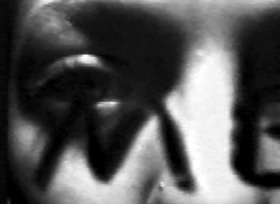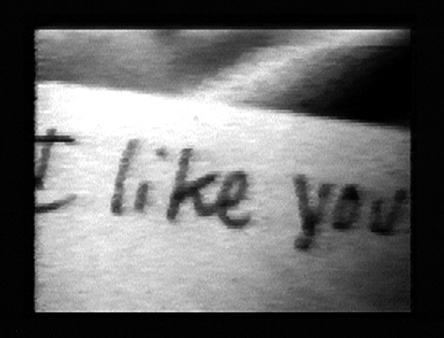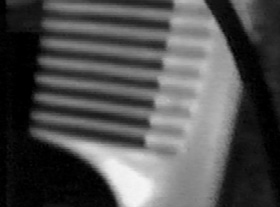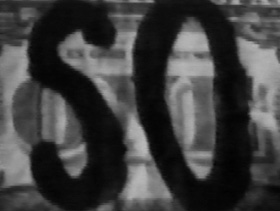This appeared in the November 15, 1991 issue of the Chicago Reader. — J.R.
VIDEOS BY SADIE BENNING
“I would like to call this new age of cinema the age of the caméra-stylo [camera-pen],” Alexandre Astruc wrote prophetically in 1948 in the journal Écran français. “This metaphor has a very precise sense. By it I mean that the cinema will gradually break free from the tyranny of what is visual, from the image for its own sake, from the immediate and concrete demands of the narrative, to become a means of writing just as flexible and as subtle as written language . . .
“It must be understood that up to now the cinema has been nothing more than a show. This is due to the basic fact that all films are projected in an auditorium. But with the development of 16-millimeter and television, the day is not far off when everyone will possess a projector, will go to the local bookstore and hire films written on any subject, of any form, from literary criticism and novels to mathematics, history, and general science. From that moment on, it will no longer be possible to speak of the cinema. There will be several cinemas just as today there are several literatures, for the cinema, like literature, is not so much a particular art as a language which can express any sphere of thought.”
Astruc may have faltered in a few particulars — citing television rather than videotape, projectors rather than VCRs, and bookstores rather than video-rental outlets — but in many important ways he got it right. Forty-three years later, the age of the caméra-stylo has certainly arrived, although whether we fully realize it is quite another matter. Because Hollywood still dictates a good 85 percent or more of what most people regard as “the cinema,” whether they see it at home or in a theater, the notion of video as “a means of writing just as flexible and as subtle”–and almost as universally available–“as written language” exists more as an exciting possibility than as an everyday reality.
The reason may be other cultural developments that Astruc couldn’t foresee. For one thing, written language has itself suffered a precipitous decline over the same 43-year period. (The corresponding decline in literacy is apparent to anyone who has ever read student papers.) For another, new technologies by no means guarantee new aesthetics or ideologies; on the contrary, despite an avalanche of economically motivated hype telling us the sky’s the limit, to date new technologies have mainly meant either a brutal reinforcement of old Hollywood codes and models or the foreclosure of certain options (such as the use of black and white). Maybe in theory the sky is the limit; but in practice and in the broader marketplace, the menu of choices is conceivably narrower now than it’s ever been.
Back in the 60s, the development of portable, lightweight 16-millimeter cameras and sound equipment was heralded by many as the realization of Astruc’s dream — and so it was, to some extent, for certain documentary and experimental filmmakers. Something similar happened in the early 80s, after the cheaper form of Super-8 became available. More recently the development of portable, lightweight, and relatively inexpensive camcorders has stirred up similar hopes of realizing new possibilities, but the results so far have mainly been practical or kitschy rather than aesthetic. (The videotape of Los Angeles cops brutally beating a motorist and national broadcasts of home videos are the examples that spring to mind.)
Many film people in the 60s and 70s thought that a media revolution would come about once teenagers got hold of cheap equipment. More recently, thanks to camcorders, speculation has been renewed that young people will revolutionize the media. But until I saw the videos of Sadie Benning — showing this Saturday at Chicago Filmmakers as part of the Chicago Lesbian & Gay International Film Festival — I hadn’t seen any evidence that these expectations were being fulfilled.
It would be incorrect at this point to call the work of 18-year-old Sadie Benning a bolt from the blue. Several of her videos, made over the last couple of years, have had screenings in alternative spaces in New York, Chicago, and Milwaukee (where she lives), as well as Los Angeles, San Francisco, Berkeley, and Rotterdam, among others. Chicago’s Video Data Bank, which distributes her work, reports that she’s had about a dozen and a half shows to date. (She’s also made one short film in color, Welcome to Normal, which won’t be part of this weekend’s program.)
Benning is the daughter of experimental independent filmmaker James Benning, whose best-known works include 11 x 14 (1976), One Way Boogie Woogie (1977), Grand Opera (1979), and Landscape Suicide (1987). She made her first video, New Year, when she was 15, with a cheap plastic video camera — a Fisher-Price Pixelvision 2000 — that her father gave her for Christmas; all her subsequent videos have been made with this same toy camera, in her working-class, racially mixed neighborhood. I’m told that both her father and Eric Saks (Forevermore: Biography of a Leach Lord) have also done some video work with the same kind of camera, but her work bears very little resemblance to the films by James Benning and Saks I’ve seen. (The Fisher-Price Pixelvision camera — which cost about $100 and used audiotape instead of videotape — has since been taken off the market. So much for the enlarged freedoms that new technologies are supposed to bestow automatically, like gifts from heaven.)
The most striking visual effect produced by this camera –apart from a very rough-grained look, the opposite of high-definition television — is the clearly demarcated rectangular image framed by black on all sides. It doesn’t have the curved, less defined frame boundaries of other video images (including most movies shown on video, unless they’re “letterboxed” — surrounded by black borders). This creates an unusually intimate effect, almost like a peep show. This intimacy and the grainy look bring one back to qualities found in some of the earliest movies, made around the turn of the century — especially to the sense that images are emerging out of a primordial darkness and chaos.
I’d like to consider Sadie Benning’s work chronologically, because her intimate, diaristic films trace a process of empowerment, of self-discovery and self-realization. It’s almost as if the individual videos were episodes in a serial.
A New Year (1989) shows Benning simultaneously testing out her equipment by surveying some of the contents of her room and home (TV, desk, window shades, sink, lawn, glass paperweight, dog) and defining a mode of self-expression. Significantly this includes shooting written language as a “found” object among her diverse subjects — complete with the misspellings one would expect (especially nowadays) from someone her age; usually these texts point to the world outside her home. The frequent misspellings may make one smile, but they also have some of the hard authenticity of street graffiti; like her images, her words seem conjured up out of darkness.
She begins by taping a bit of a TV program — the end of a commercial for Raisin Bran followed by two fragments of a frenetic game show. Abruptly the image freezes; her camera moves back and forth across a “New York” pennant on a wall, then scans two lines of a written text that we can’t make out and, to the accompaniment of rock music, several headlines from a tabloid newspaper, zooming in briefly on the word “super-nerd.”
Then her use of written language begins in earnest, with a poetic device that is to continue throughout her work: moving her camera slowly over a line of written text (“A girl I know got hit by a drunk driver”), cutting to something else (she pans past various objects in her room), and then moving over a second line of text (“her leg was broken & twisted like puddy”). Other equally chilling little messages appear in this five-minute film, like diary entries scattered amid various settings: “IT WOULD BE SO EASY TO DIE”; “A friend got raped by a black man,” followed by a shot of scrubbing a sink with Comet, and then “now she’s a Racist Nazi Skinhead”; “Your easily trapped when you have an exscuse”; and finally a four-line message interspersed with many other shots, “my neighboor is selling crack / as my neighbrohood dies / but our nation is addicted to a / more harmful drug [. . .] money.” Statements of this kind are like messages sent out in bottles, seemingly addressed to Benning herself and to strangers; in her next video, Benning admits she has only one friend.
Apart from a close-up of one of her eyes and a shot of her hand petting her dog, Benning keeps herself out of New Year. But self-images proliferate in her next piece, Living Inside (1989), made after she turned 16 and a week after she dropped out of high school. (“Everybody [there] called each other ‘fag’ and ‘queer,'” she told Ellen Spiro in an interview published in the Advocate earlier this year, “and the teachers would joke about gay people. I just didn’t want to be put through that abuse. I was in a really fragile stage, and I knew that if anybody knew I was gay, I would totally get tormented. School was really difficult. To be that age anyway is tough, but to be gay is just hell.”) She’s much more present in her work beginning with Living Inside, but nearly always in elliptical close-ups that either focus on isolated parts of her face or show her entire face from oblique angles. The effect is of a kind of narcissism-in-hiding, a paradoxical retreat through exposure that precisely matches the emotional tone of these tapes, which continually seek to strike an uneasy balance between secrecy and candor, shyness and angry assertion.
It’s only in her third video, Me and Rubyfruit (1989), inspired by Rita Mae Brown’s novel Rubyfruit Jungle, that she “comes out.” She deals with the fact of being a lesbian mainly through a dialogue with herself, set up between written and spoken messages, about marriage and stolen kisses; the messages are interspersed with snatches of Alberta Hunter singing, glimpses of a doll and various female models, and shots of herself. Once she arrives at lesbianism as a subject, her work gains in structure, focus, and eloquence without ever shrinking into monotony or obsession. Her color film Welcome to Normal (1990), which comes next, deals at some length with little kids, the physical landscape of her neighborhood, and home movies, apparently of herself; if lesbian desire informs most of the written and spoken messages – “What’s the sence in life if you can’t be who you are” is the first one we see — it also acts as the starting point for broader questions about identity and social molding. “I wonder how many lesbians were born today,” she muses at the end, over some of the home movies, “how many died, never knowing who they were, how many sit married, feeling empty and wondering why. I can’t say how many but that doesn’t matter, because one identity robbed is one too many.” In fact the loveliest sustained visual passage in the film occurs just before this, when her hand traces abstract patterns in a puddle of spilt milk — a metaphor that suggests desire and lost innocence as well as molding.
Her three most recent tapes — If Every Girl Had a Diary (1990), Jollies (1990), and A Place Called Lovely (1991) — show an increasing grace in handling both her camera and her environment poetically, with a fluidity that suggests she’s now able to sing as well as speak and write with her camera-stylo. Some of the anger persists, to be sure, and with good reason. But when, in Jollies, she begins to delve into her own past — including accounts of early sexual feelings and experiences both gay and straight — she seems to take a more balanced view of her life. It may be significant that A Place Called Lovely, the most lyrical and wide-ranging of all her works to date, doesn’t address lesbianism directly. It is full of related ruminations about gender and childhood, however, as well as thoughts about violence and pain — all the things she freely admits scare or trouble her, from the act of putting on lipstick to the shower murder in Psycho, from gun ads in a tabloid to a fiery car accident she witnessed.
“Last week I almost laughed,” she says in If Every Girl Had a Diary. “It’s only been a year ago that I crawled the walls. . . . You know, I’ve been waiting for the day to come when I could walk the streets. People would look at me and say, ‘That’s a dyke.’ And if they didn’t like it, they’d fall into the center of the earth and deal with themselves. Maybe they’d return, but they’d respect me.”







